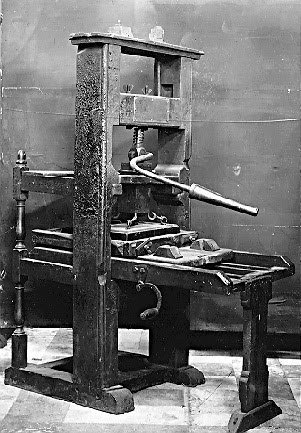Abstract
Gutenberg is considered the inventor of movable metallic type that made printing many books at once practical for the first time.

The father of Modern printing ,Johannes Gensfleisch zur Laden zum Gutenberg was a German goldsmith, printer and publisher who introduced modern book printing. His invention of mechanical movable type printing started the Printing Revolution and is widely regarded as the most important event of the modern period.It played a key role in the development of the Renaissance, Reformation and the Scientific Revolution and laid the material basis for the modern knowledge-based economy and the spread of learning to the masses
Gutenberg is considered the inventor of movable metallic type that made printing many books at once practical for the first time. Movable type revolutionized printing, fostered the standardization of type size and ushered in the beginning of mass communication in fifteenth century Europe.
Printed books had been in existence long before Gutenberg. The oldest surviving book is one from China produced in 868 AD. when wooden blocks were engraved with characters and then inked. Eleventh century Chinese books show that printing was accomplished with some movable type. However, because Asian languages use thousands of complex characters for words rather than letters of an alphabet, movable type had a limited practicality. In Europe, perhaps twenty years before Gutenberg, a Dutch church official, Laurens Janszoon Coster, is credited with using some movable type but not with the precise system set up by Gutenberg.
 Gutenberg was born sometime between 1395 and 1400 in Mainz, Germany to a wealthy, political family named Gensfleisch, but was most often known by his mother’s name, Gutenberg. Little is known of his youth other than he was a member of the goldsmith’s guild. Local political upheaval caused him to be exiled from Mainz and he moved to Strasbourg, Germany, where he worked in secret with partners on his printing inventions. Gutenberg was working on the letterpress,a mold for each individual letter of the alphabet cast out of equal amounts of metal alloy.
Gutenberg was born sometime between 1395 and 1400 in Mainz, Germany to a wealthy, political family named Gensfleisch, but was most often known by his mother’s name, Gutenberg. Little is known of his youth other than he was a member of the goldsmith’s guild. Local political upheaval caused him to be exiled from Mainz and he moved to Strasbourg, Germany, where he worked in secret with partners on his printing inventions. Gutenberg was working on the letterpress,a mold for each individual letter of the alphabet cast out of equal amounts of metal alloy.
The letters could be arranged into words along even lines and then locked together into a rigid form, making a page. The form was placed in a printing press and the letters covered with inks similar to paints. When sheets of paper pressed against the letters, thousands of copies of the same page could be produced in a short time. With this invention, the type could then be separated and reused to make other pages. This process could make books faster and cheaper to manufacture.
 On the death of one of his partners, the nature of Gutenberg’s invention was debated in a trial, at which the partner’s heirs sued Gutenberg. Gutenberg won the lawsuit and later, became partners with a wealthy benefactor named Johann Fust, who wanted to print a book that would sell many copies.
On the death of one of his partners, the nature of Gutenberg’s invention was debated in a trial, at which the partner’s heirs sued Gutenberg. Gutenberg won the lawsuit and later, became partners with a wealthy benefactor named Johann Fust, who wanted to print a book that would sell many copies.
The two agreed to work on a Bible. This led to the most well known achievement, Gutenberg Bible, printed in 1455. It is also called the 42 line Bible, referring to the fact that every page had 42 lines. However, Gutenberg wanted to spend time working on other creative projects and perfecting his printing process. This led Fust to sue Gutenberg and this time Gutenberg was the loser. Then Fust and his son-in-law Peter Schoffer, a calligrapher and former Gutenberg student, became printers of a famous Hymn Book in 1457,which is credited to Gutenberg.
Gutenberg did enjoy the fruits of his labor later in his life by being named a member of the royal court and receiving a yearly allowance till his death in 1468 .Printing was the first mass production industry, allowing one person, a printer, to do the work formerly done by many scribes. Its impact on communication was far-reaching.




